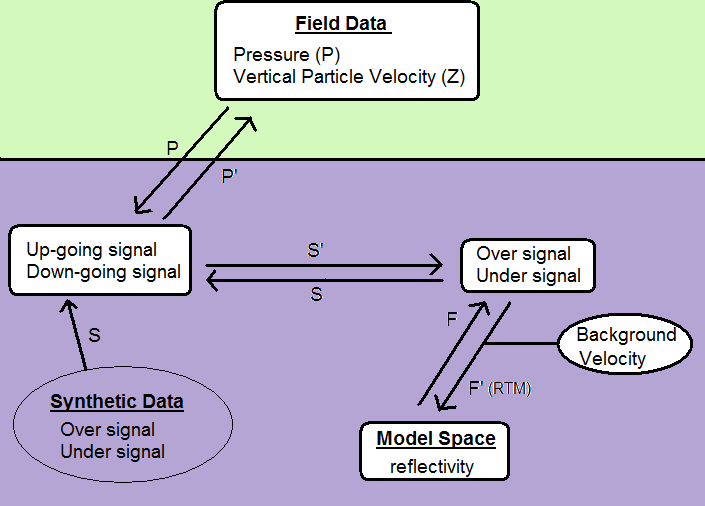|
|
|
|
Reverse Time Migration of up and down going signal for ocean bottom data |
The goals of our joint inversion scheme are threefold:
 ). To make use of the
). To make use of the  measurement, we would need to apply elastic modeling. Our proposed joint inversion scheme will avoid this difficulty.
measurement, we would need to apply elastic modeling. Our proposed joint inversion scheme will avoid this difficulty.

|
|---|
|
Flowchart2
Figure 6. This flowchart shows the relationship between multi-component pressure (P) and vertical particle velocity (Z) data, up- and down-going data, and over/under data. Reverse time migration (RTM) is performed with over/undre data and generate reflectivity in migration using a background velocity model. [NR] |
|
|
Our proposed scheme can be summarized using the flowchart in Figure 6. Field data ![]() and
and ![]() can be converted into up-going and down-going data at the receiver level by applying the PZ summation operator
can be converted into up-going and down-going data at the receiver level by applying the PZ summation operator ![]() . There are many ways to implement PZ summation; one of the simplest is described in Wong et al. (2009).
. There are many ways to implement PZ summation; one of the simplest is described in Wong et al. (2009).
Next, up- and down-going data can be converted into over- and under- data using the adjoint of the separation operator  :
:
![$\displaystyle \left[ \begin{array}{c}
\tilde{d_{o}} \\
\tilde{d_{u}}
\end{arra...
...rray}{c}
\tilde{d_{\uparrow}} \\
\tilde{d_{\downarrow}}
\end{array} \right].
$](img57.png)
RTM is performed using over and under data via the RTM operator, denoted as  :
:
Since all three operators are linear, we can do acoustic RTM on  and
and ![]() by applying a cascade of these operators, denoted as
by applying a cascade of these operators, denoted as ![]() :
:
We claim that by applying the inverse operator
 instead of the adjoint operator
instead of the adjoint operator ![]() , the three goals discussed at the beginning of the section can be achieved. The testing of this theory is the focus of our current research.
, the three goals discussed at the beginning of the section can be achieved. The testing of this theory is the focus of our current research.
|
|
|
|
Reverse Time Migration of up and down going signal for ocean bottom data |